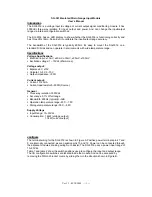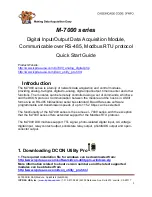
NV8256-Plus Digital Video Router • User’s Guide
15
2. Introduction
Active Cards
Active Cards
The NV8256-Plus features several active cards that manage incoming signals, process commands
from the control system, perform signal switching, and distribute outgoing signals. Each card slides
into a card guide and has a lever that holds the card in place and aids card ejection.
There are:
• 2 control cards
—
one primary, one secondary (optional for redundancy)
• Up to 16 input cards
—
SD, SWB, 3Gig signals or analog-to-SD conversion.
• Up to 16 output cards
—
SD, SWB, 3Gig signals or SD-to-analog conversion.
• Up to 3 crosspoint cards
—
one primary, one optional for redundancy, and one for expansion.
• 1 monitor card (optional)
Each card and function is described in the following section. For information on installing cards,
see
on page 30.
Control Cards
The router has two control cards (EM0374), one primary and one secondary used for standby
(optional for redundancy). Each card receives commands from the router control system, and in
turn, controls the input, output, crosspoint and monitor cards. Only one control card is active at a
time, with the active card updating the stand-by card.
The control card includes a status reporting circuit. Four LEDs on the front of the control card indi-
cate the card’s status: low battery (Red), alarm (Red), active (Amber) and “healthy” (Green). For
more information, see
Input Cards
The router frame can house up to 16 input cards, each processing up to 16 signals. Input cards
receive incoming signals through coaxial connectors or through expansion connectors when two
routers are connected together. There are three categories of input cards: Standard, filler, and ana-
log-to-SD. The standard input card manages incoming signals from the coaxial connections and
from the expansion connections when two routers are connected. The filler input card manages
incoming signals only from the expansion connections when two routers are connected. Both stan-
dard and filler input cards can manage SD, SWB or 3Gig signals. Analog-to-SD input cards convert
incoming analog composite video signals to SD. Different categories of input cards can be inter-
mixed in a single frame to meet specific switching configuration needs. For more information on
switching configurations, see
The following is a list of the different input cards available. Each card is listed by the function it
performs (category)
—
standard, filler or analog-to-SD
—
and the type of signal it manages
—
SD,
Note
All crosspoint cards in this section are referred to by the slot in which the card is
installed—
left
,
middle
or
right
—when facing the front of the router with the door
open.
Summary of Contents for NV8256-Plus
Page 10: ...x Rev 1 3 29 Mar 09 Table of Contents ...
Page 60: ...50 Rev 1 3 29 Mar 09 3 Installation Verification ...
Page 66: ...56 Rev 1 3 29 Mar 09 5 Configuration UniConfig ...
Page 72: ...62 Rev 1 3 29 Mar 09 6 Maintenance Obtaining Service ...
Page 82: ...72 Rev 1 3 29 Mar 09 9 Part Numbers Frame Expansion ...
Page 88: ...78 Rev 1 3 29 Mar 09 Index ...
















































